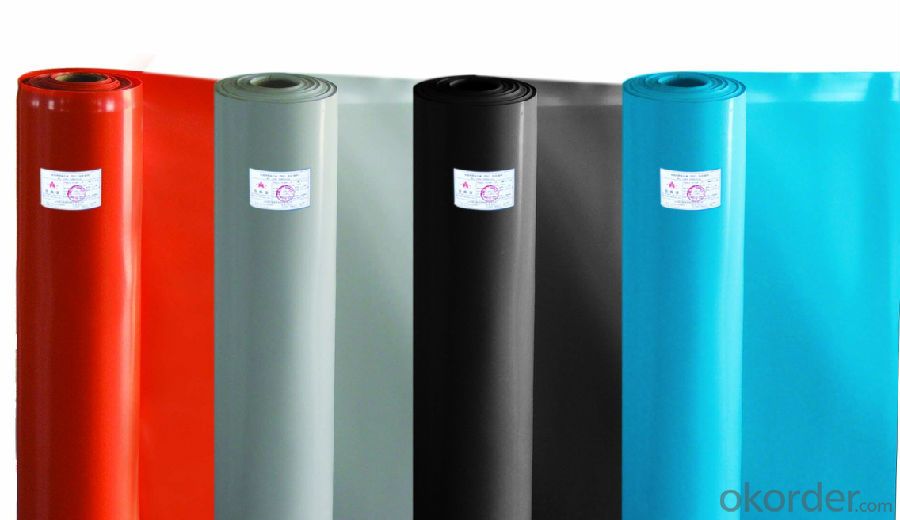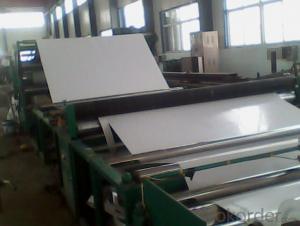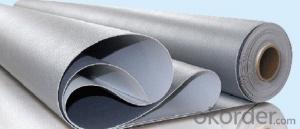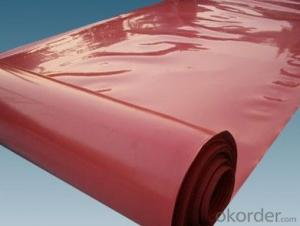Products Description of Thermoplastic Polyolefin (TPO) waterproof membrane
- Loading Port:
- Qingdao
- Payment Terms:
- TT or LC
- Min Order Qty:
- 20000 m²
- Supply Capability:
- 600000 m²/month
OKorder Service Pledge
OKorder Financial Service
You Might Also Like
Products Description of Thermoplastic Polyolefin (TPO) Waterproof Membrane:
The Thermoplastic Polyolefin (TPO) waterproof membranes are the most popular waterproof materials in the world at present. It’s thermoplastic elastomeric waterproof materials by adopting advanced polymerization together with squeeze technology,which perform well in mechanical properties, high tensile strength,oxidation-resistance and resistance to puncture.
Product Features of Thermoplastic Polyolefin (TPO) Waterproof Membrane:
1.High UV-resistance and high reflectivity
2. Excellent weathering characteristics and long-term flexibility
3.High tensile strength and puncture resistance
4. Excellent resistance to harsh chemicals and industrial pollutas
5.Heat or solvent-welding effectively provides seamless roof covering
TPO Physical Properties of Thermoplastic Polyolefin (TPO) Waterproof Membrane:
Item | Specification | |||||||
H | L | P | G | GL | ||||
The resin thickness of Middle fabric, mm≥ | — | 0.40 | ||||||
Maximum tension,N/cm ≥ | — | 200 | 250 | — | 200 | |||
Tension strength,Mpa≥ | 12 | 12 | ||||||
Maximum tension elongation,%≥ | 15 | |||||||
Fracture elongation,%≥ | 500 | 250 | 400 | 200 | ||||
Heat treatment size change rate %≤ | 2.0 | 1.0 | 0.5 | 0.1 | 0.1 | |||
Low temperature bend | -40°C No crack | |||||||
Water tightness | 0.3Mpa,2h, No seepage | |||||||
Attack resistance | 0.5kg·m,No seepage | |||||||
Static charge resistance | — | 20kg ,No seepage | ||||||
Seam strip strength ,N/mm≥ | 4.0 or Membranes break | 3.0 | ||||||
Right-angle tear strength,N/mm≥ | 60 | 60 | ||||||
Trapezoid tear strength N≥ | — | 300 | 450 | 350 | ||||
Bibulous rate (70°C 168h), % | After soaking≤ | 4.0 | ||||||
Air-cure later≥ | -0.40 | |||||||
Heat aging (115°C)
| Time | 672h | ||||||
Appearance | No blister,flaw,delamination,coherence,hole | |||||||
Tensile strength retention,%≥ | 90 | |||||||
Elongation rate of keeping,%≥ | 90 | |||||||
Low temperature bend | -40°C, No crack | |||||||
Chemistry resistance | Appearance | No blister,flaw,delamination,coherence,hole | ||||||
Tensile strength retention,%≥ | 90 | |||||||
Elongation rate of keeping,%≥ | 90 | |||||||
Low-temperature bending | -40°C, No crack | |||||||
Artificial weather accelerated aging | Time | 1500hb | ||||||
Appearance | No blister,flaw,delamination,coherence,hole | |||||||
Tensile strength retention%≥ | 90 | |||||||
Elongation rate of keeping%≥ | 90 | |||||||
Low temperature bend | -40°C ,No crack | |||||||
FRQ:
What is your main market?
Our Tpo Roofing Membrane with Superior Raw Material for Roofing Market sells very well in USA, United Kingdom, Austrilia, Canada, Japan, Pakistan, etc.
What is your advantage for Tpo Roofing Membrane?
With the most advanced production line, our good quality is based on superior material imported from America. We have different color available and could produce any color you want.


- Q:Can waterproofing membranes be used in cold climates?
- Waterproofing membranes are applicable in cold climates. They are specially engineered to safeguard against moisture and water infiltration in diverse weather situations, including cold temperatures. These membranes are commonly constructed from sturdy and pliable materials that can endure freezing temperatures without fracturing or declining in quality. Furthermore, certain waterproofing membranes incorporate supplementary characteristics such as thermal insulation, which aids in preventing heat loss and upholding a cozy indoor atmosphere in cold climates. All in all, waterproofing membranes serve as a successful remedy for guaranteeing the soundness and durability of structures in cold weather circumstances.
- Q:Are there any special tools required for installing a waterproofing membrane?
- Installing a waterproofing membrane necessitates the use of various specialized tools. The specific tools required can differ depending on the type of membrane being installed, though some commonly used tools include a trowel or brush to apply the membrane, a utility knife to cut the membrane to the appropriate size, a roller for ensuring proper adhesion, and a heat gun to activate any adhesive properties of the membrane. In addition, other tools such as a measuring tape, level, and caulking gun may be required to ensure accurate installation. To guarantee that the correct tools are utilized for the specific membrane being installed, it is essential to refer to the manufacturer's instructions and recommendations.
- Q:Can a waterproofing membrane be used for fountains or water features?
- Indeed, fountains or water features can make use of a waterproofing membrane. Such membranes find widespread use across various applications, encompassing below-grade waterproofing, roofing systems, and even ponds. Their purpose is to establish a barrier against water infiltration, thereby safeguarding the underlying structure against water-related harm. In the context of fountains or water features, a waterproofing membrane serves to avert leaks and seepage, ensuring that the water remains confined within the intended boundaries. Furthermore, these membranes typically possess flexibility and durability, rendering them well-suited for deployment in areas subject to perpetual water exposure and potential movement.
- Q:Can a waterproofing membrane be used for restaurants or kitchens?
- Yes, a waterproofing membrane can be used for restaurants or kitchens. Waterproofing membranes are commonly used in these areas to protect the underlying structure from water damage. They are typically installed in areas prone to water exposure such as floors, walls, and countertops. Waterproofing membranes help prevent water from seeping into the building materials, which can cause deterioration, mold growth, and other issues. Additionally, these membranes are designed to be resistant to chemicals and stains commonly found in restaurant or kitchen settings. Overall, using a waterproofing membrane is an effective way to ensure the durability and longevity of the restaurant or kitchen, while also maintaining a clean and hygienic environment.
- Q:Can a waterproofing membrane be used in hot climates?
- Yes, a waterproofing membrane can be used in hot climates. The membrane is designed to withstand various weather conditions, including high temperatures, and is effective in preventing water ingress regardless of the climate.
- Q:Can a waterproofing membrane be used for shopping malls or commercial buildings?
- Yes, a waterproofing membrane can be used for shopping malls or commercial buildings. Waterproofing membranes are commonly used in construction to provide a protective barrier against water infiltration, which is crucial for the longevity and maintenance of buildings. They are particularly effective in areas prone to heavy rainfall or where water exposure is a concern, making them suitable for shopping malls and commercial buildings where water damage can be costly and disruptive.
- Q:Can a waterproofing membrane be used in geotechnical applications?
- Yes, a waterproofing membrane can be used in geotechnical applications. Waterproofing membranes are commonly used to prevent the infiltration of water into structures and are applied to various surfaces such as roofs, basements, and foundations. In geotechnical applications, these membranes can be utilized to prevent water from seeping into soil, preventing erosion, and stabilizing slopes. They can be installed horizontally or vertically to create a barrier that prevents water penetration, which can be particularly useful in retaining walls, embankments, and dams. Additionally, waterproofing membranes can also be used to control the flow of water and improve drainage in geotechnical projects. Overall, the use of a waterproofing membrane in geotechnical applications can enhance the durability and performance of structures while protecting against water-related issues.
- Q:Can a waterproofing membrane be used for basements?
- Yes, a waterproofing membrane can be used for basements. In fact, it is one of the most effective solutions for preventing water infiltration and moisture damage in basements. A waterproofing membrane is a thin layer of material that is applied to the exterior walls and/or floors of a basement to create a barrier against water. It is designed to withstand hydrostatic pressure, which is the force exerted by water against the walls and floors. By installing a waterproofing membrane, you can significantly reduce the risk of water damage, mold growth, and structural problems in your basement. It is important to note that proper installation and maintenance of the membrane are crucial for its effectiveness, so it is recommended to consult with a professional waterproofing contractor for the best results.
- Q:Can waterproofing membranes be used on swimming pool decks?
- Yes, waterproofing membranes can be used on swimming pool decks. Waterproofing membranes are designed to create a barrier against water penetration, making them an ideal solution for areas that are constantly exposed to water, such as swimming pool decks. By applying a waterproofing membrane to the deck surface, it helps to prevent any water from seeping through and causing damage to the underlying structure. Additionally, waterproofing membranes can also provide protection against chemicals, UV rays, and general wear and tear, which are common in swimming pool environments. Overall, using waterproofing membranes on swimming pool decks can help extend their lifespan, reduce maintenance costs, and enhance the overall safety and appearance of the area.
- Q:Can a waterproofing membrane be used in agricultural structures?
- In agricultural structures, like barns, greenhouses, and storage facilities, it is possible to utilize a waterproofing membrane. These structures often necessitate protection against moisture and water harm. A waterproofing membrane is a robust and flexible substance that can be applied to diverse surfaces such as roofs, walls, and floors to obstruct water infiltration. It functions as a barrier, stopping water from penetrating the structure and causing destruction to the building materials, equipment, and stored crops. Moreover, a waterproofing membrane can also assist in regulating the temperature and humidity levels within the agricultural structure, generating a more controlled and ideal environment for crops, livestock, and equipment. In summary, the utilization of a waterproofing membrane in agricultural structures can guarantee the durability and functionality of the building while safeguarding the valuable assets inside.
1. Manufacturer Overview |
|
|---|---|
| Location | |
| Year Established | |
| Annual Output Value | |
| Main Markets | |
| Company Certifications | |
2. Manufacturer Certificates |
|
|---|---|
| a) Certification Name | |
| Range | |
| Reference | |
| Validity Period | |
3. Manufacturer Capability |
|
|---|---|
| a)Trade Capacity | |
| Nearest Port | |
| Export Percentage | |
| No.of Employees in Trade Department | |
| Language Spoken: | |
| b)Factory Information | |
| Factory Size: | |
| No. of Production Lines | |
| Contract Manufacturing | |
| Product Price Range | |
Send your message to us
Products Description of Thermoplastic Polyolefin (TPO) waterproof membrane
- Loading Port:
- Qingdao
- Payment Terms:
- TT or LC
- Min Order Qty:
- 20000 m²
- Supply Capability:
- 600000 m²/month
OKorder Service Pledge
OKorder Financial Service
Similar products
New products
Hot products
Hot Searches
Related keywords






























